Clematis pruning rules - gardener recommendations
Pruning clematis is a necessary procedure to contain growth, give the shrub a compact shape and ensure high-quality flowering. Let's consider how to properly conduct an event.
Classification of clematis
All hybrid forms of clematis are divided into groups. They differ in the size and shape of the inflorescences, as well as the length of the shoots.
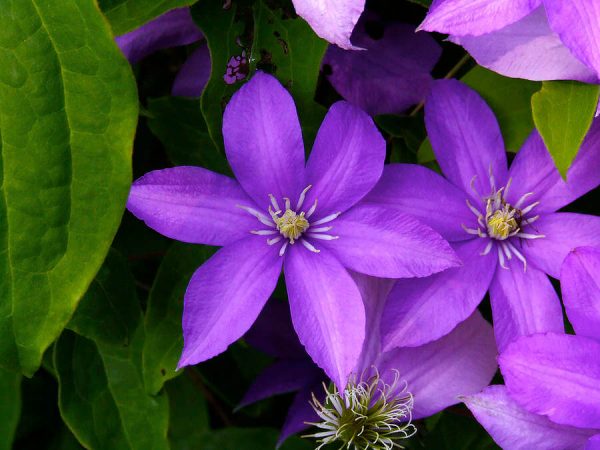
Clematis winter shelter and pruning
Large-flowered
This group includes plants with large and bright flowers.
- Zhakman. The main differences are a well-developed rhizome, a large and spreading crown, which develops rapidly - during the season the shrub forms 11-12 shoots up to 4 m long. The leaves are dark green, pyalylopate. The flowers are bright purple with a bright lemon-colored core, 15-16 cm in diameter.
- Lanuginose (Woolly clematis). Compact shrub vine, reaching 2.5 m in height. The leaves are long - up to 12 cm, glossy above, rough below. The flowers are large in size, bloom at the tops of the shoots, consist of white, pale pink or purple petals. The diameter of the inflorescences is 12-20 cm.
- Patens. Includes varieties and hybrids developed on the basis of Sprawling Clematis. Almost all plants have a wide aboveground part - up to 3.5 m in circumference. The flowers are single, in the form of a five-pointed star, 15 cm in diameter. The color is varied - blue, burgundy, purple. There are varieties with double inflorescences.
- Florida. Plants of this group were obtained on the basis of flowering clematis. Shrub varieties with branches up to 3 m long, emit a pleasant aroma, diameter - 8-12 cm. Petals of different shades - white, pale pink, light lilac.
Small-flowered
The description of plants in this group includes abundant, aromatic and long flowering. Most varieties have bell-shaped inflorescences.
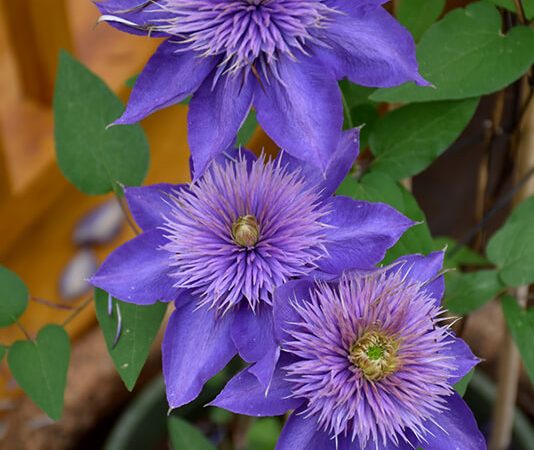
Pruning clematis for the winter
- Viticella. Clematis Violet was taken as the basis for breeding new shrub vines. This is a plant with creeping, woody shoots 4-5 m long. It is characterized by fast growth and good resistance to severe frosts - it hibernates without shelter. Leaves are medium in size - 6 cm, compound, consist of 5-6 small leaves. The flowers are large - 12-13 cm in diameter, in different shades - red-purple, violet-blue, lilac or two-color. Long bloom - from June to September.
- Flamula. The varieties of this group were bred on the basis of crossing two varieties - Clematis Burning and Trizhdytroichatoy. They tolerate wintering well without insulation, bloom on the shoots of the current season. The inflorescences are medium in size, of different colors - snow-white, light pink or pale lilac.
- Tangutica, or Tangut. Deciduous, small-flowered liana with woody shoots reaching 3-4 m in length. Inflorescences are small, yellow, bell-shaped. Blossom in mid-June and bloom in the first half of September.The varieties of this group have a good degree of frost resistance - they can safely tolerate a decrease to -30 ° C.
- Texensis. Clematis Texas and large-flowered varieties were taken as a basis. The result is new hybrid forms with drooping tulip-shaped inflorescences that bloom in late summer. The plant is compact - shoots reach 2 m in height.
- Vitalba. A grape-leaved species, on the basis of it varieties with small cream or white flowers have been bred. Blooms throughout the summer.
- Atragene (Princes). The group is represented by shrub vines 2-2.5 m high. The leaves are light green with jagged edges. Flowers drooping, bell-shaped, 5-6 cm in diameter, lilac, snow-white or purple tones.
Herbaceous
These are perennial vines, which are still little known, but every year the demand for them is increasing.

Clematis shelter for the winter and pruning
- Flamula-Rekta. This group consists of varieties and hybrids obtained by crossing three species - Clematis Aromatny, Direct and Manchurian. Climbing plants, need a garter to any support. Flowering begins in July.
- Heracleifolia. Includes Clematis Barshevikolistny and its hybrid forms. Grown as weaving lianas and ground cover. Flowering occurs in July.
- Integrifolia. Presented by hybrids of Clematis Whole-leaved. These are vigorous semi-shrub lianas with a height of 1.5 to 2.5 m. Flowers are small, bell-shaped, collected in inflorescences of 3 pcs. The circumference of the buds is 10-12 cm. The petals are of different shades - blue, purple, white or lilac.
Browse varieties by trim group
For each variety and hybrid, a specific pruning scheme and technique is used.
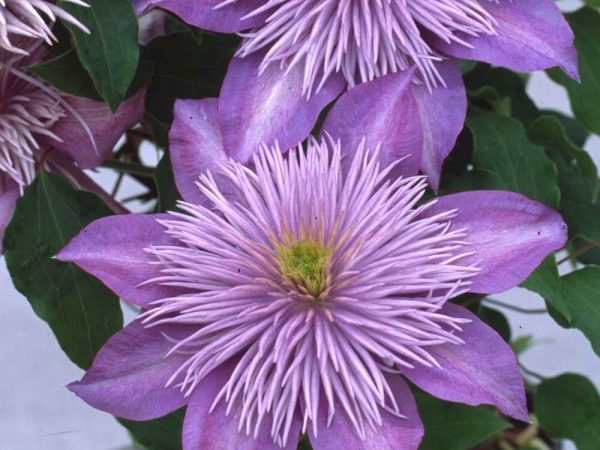
Clematis - soft pink flower
- The first (A) is suitable for clematis of the Atragene group and other hybrids that can be grown without pruning. Famous varieties - Alpine, Large-scale, Mountain, Flowery.
- The second (B) is used for plants of the Florida, Patens, Lanuginoza groups. Popular varieties are Daniel Deronda, Royalty, Chania, Yulka, Henry, Snow Queen, Turislund, Carnabi, Josephine, Laura and Omoshiro.
- The third (C) pruning is carried out for varieties and hybrids of the Jacquemann, Viticell group and their hybrids - Cloudbarst, Gouvey, Star of India, Blue Angel, Crispina, Long Fire, Bill Mackenzie, Cardinal Rouge, Rhapsody, Change of Hart, Morning Sky.
Pruning technologies
There are three types of clematis pruning, each with specific terms and rules. Step-by-step instructions for beginners will help you to carry out this manipulation correctly.
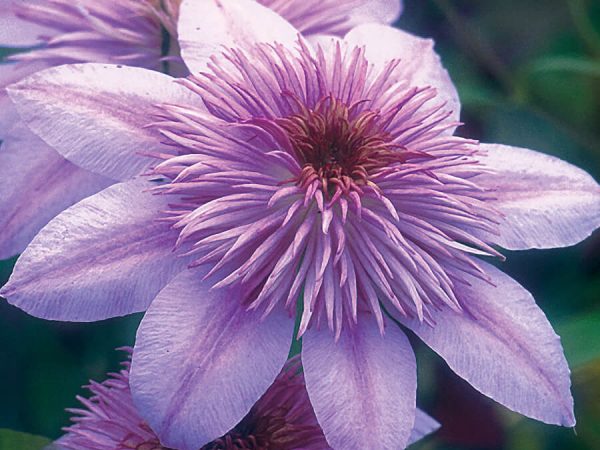
Description and photo of clematis trimming them
For the first group
Vines form flowers on last year's branches. Light pruning required. It consists in removing weak, twisted, broken off and dry branches, as well as young, not yet lignified shoots. All other branches need to be pinched at a third of the length, leaving the vines at a height of 1-1.5 m from the ground.
The procedure is carried out in the fall, when the shrub leaves the leaves.
For the second group
Plants of this group develop flowers on last year's branches and shoots of the current year. Flowering occurs twice a season - first, the inflorescences bloom on overwintered stems, then on a young growth.
You need to prune the shrub in late autumn, when it fades. Some gardeners prefer to cut branches at a height of 50-100 cm, others 100-150 cm, so you will have to make your own choice and determine the optimal length of each branch.
For adult clematis, a rejuvenating procedure will be required - the old branches are shortened to the first true leaf.
In addition to shaping pruning, a sanitary haircut is also necessary - all branches damaged by diseases, pests, winds, as well as dried fragments, are cut out.
For the third group
It is made up of plants that bloom in the summer season. The buds form on the branches of the current season. A cardinal haircut is used, which is carried out in late autumn.The branches are cut close to the ground, leaving 2-3 knots. Also, all questionable parts are cut out - dry, diseased, twisted and moldy.
Regardless of the type of pruning, a sterile and sharp instrument is used - scissors or pruning shears. After the procedure, irrigate with a solution of copper sulfate. This will help to avoid contracting various infections.
Universal way
The haircut is also called combined. It is suitable for hybrid forms or old vines.
Plants from the age of three years are pruned more - at the level of 1-2 internodes from the surface of the earth. This promotes rejuvenation and stimulates the growth of young growth.
For the young, a weaker haircut will be required - 10-12 knots are left. This method stimulates early flowering on overwintered weakened branches. Later, flowers bloom on the shoots of the current year.
Pinching
To get a lush and densely branching shrub, it is necessary to pinch last year's shoots in the spring, when the above-zero temperature stabilizes within 1-5 ° C. It is important to have time to do this before bud break.
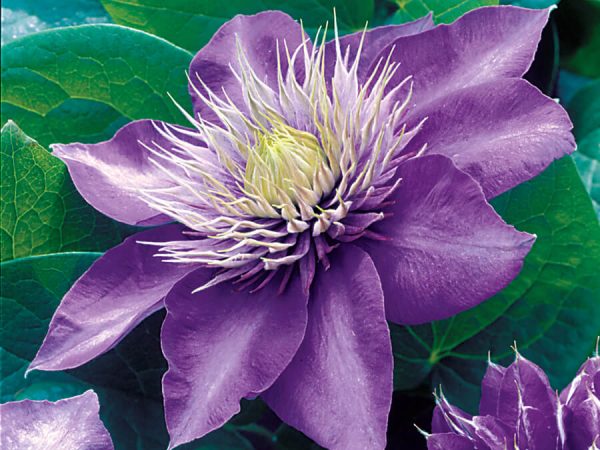
Do I need to prune clematis for the winter?
After pinching the tops, the plant will rapidly release young shoots, which will create a lush and dense crown this year.
Also, spring pinching is needed for seedlings after planting. It is carried out after a week of adaptation. Pinch the upper parts of the stems so that they begin to build up lateral shoots.
How to properly cover after pruning
Pruning clematis for the winter involves further sheltering the plant. To do this, the branches are carefully bent to the ground, then pinned with staples, covered with fallen leaves, spruce branches, sprinkled with sawdust or peat.
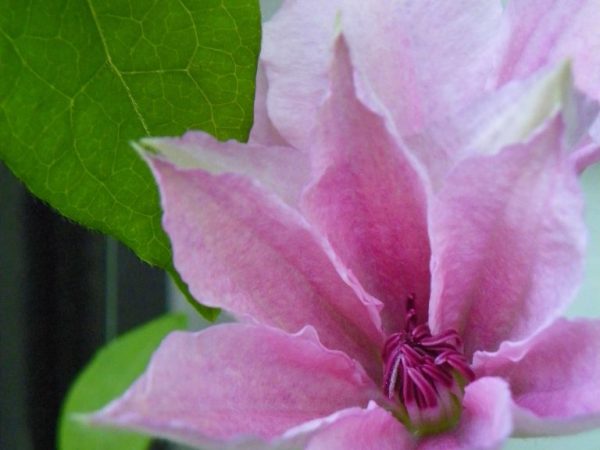
When to pinch clematis
All insulation procedures must be carried out before persistent cold weather. The insulation material is removed in the spring, when the threat of recurrent frosts has passed and the snow thaws.

